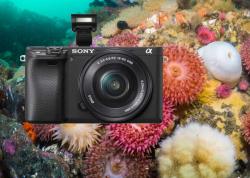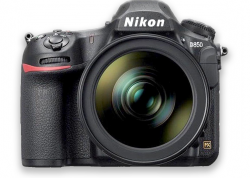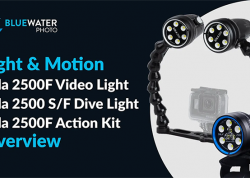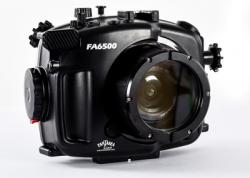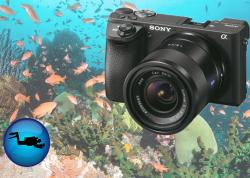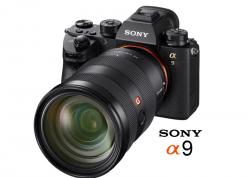SEA&SEA YS-D2 vs YS-D1 Strobe Comparison
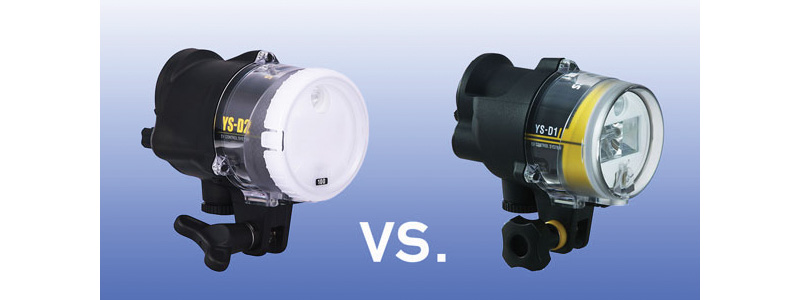
The SEA&SEA YS-D2 strobe is the latest in a line of very popular strobes for underwater photography. Compact, powerful and quick to recycle, the YS-D1 took the dive world by storm. The YS-D2 builds on this success, adding some new features and addressing some of the minor "inconveniences" of the previous model.
We decided to test the new YS-D2 against the YS-D1. Kelli also took two demo YS-D2s to the Sea of Cortez for a week of real world testing. This is what we've found.
YS-D2 vs YS-D1 Strobe Power
The SEA&SEA YS-D2 strobe is rated to have the same power as the YS-D1. We tested this in a dark room, firing first one strobe and then the other on manual power from the exact same position. Camera was on a tripod, holding each strobe directly above. You can see in the histogram pics below that both strobes do indeed fire with the same power intensity.
The front of the YS-D2 strobe (left) looks identical to that of the YS-D1 (right).

You can see in the histogram photos above that the YS-D2 power levels at max, half and low power match those of the YS-D1.
Strobe Recycle Time Comparison
We decided to test the recycle time of the SEA&SEA YS-D2 against that of the YS-D1. To do this, I put fully charged Eneloop batteries in each strobe and connected them to an Olympus OM-D E-M5 Mark II via dual sync cord. The sync cord eliminated any consideration of the camera's flash recycling, while manual settings and manual focus ensured the camera would always fire when I pushed the shutter. Both strobes were set manually to full power to ensure the capacitors fully recycled.
We found three interesting things, as you can see in the video below:
1) The strobes recycle and fire at the same rate.
2) The YS-D2 circuitry is much smoother and nicer than that of the YS-D1. The LED light promptly turns on and off to indicate power while the light on the YS-D1 was slightly delayed.
3) You can hear the YS-D2's new Audible Confirmation beep when the strobe is ready to fire again, and see the glowing back panel, which stays lit even while the strobe is recycling.
Why does recycle time matter? See the photos and caption below.

In this sequence, you can see that I was surprised by the sea lion's approach, firing too early and missing the shot as my YS-D1s recycled.
Modeling Light Features
One of the big upgrades between the YS-D1 and YS-D2 is the addition of two power levels for the modeling light. The button has been moved from the mode dial to the center of the back panel. One push turns on the modeling light at full intensity. Another push reduces the intensity. A third push turns the modeling light back off.
The YS-D2 ships with a red plastic insert to cover the modeling light, allowing you to use it as a red focus light if you so choose. Unfortunately, the piece is small and easy to lose if you try popping it in and out underwater, so decide whether you will use the modeling light as white or red before your dive.
Note: We recommend using a dedicated focus light for macro photography, since your stobes will rarely be pointing directly at your subject if using proper positioning techniques.
The diffusers packaged with the YS-D2 (left) differ in that they have a red filter you can pop into place as a red focus light.
YS-D2 vs YS-D1 Strobe Control Panels
The biggest difference between the YS-D1 and YS-D2 is the control panel on back of the strobe. The mode knob on the YS-D1 has a reputation for being bumped out of position when moving the strobe head (adjusting strobe positioning), especially when using thick gloves.
The YS-D2 addresses this with a new mode knob. The shape and increased resistance make it highly unlikely to be moved accidentally. The labeling is also much, much better for firing with pre-flash, without pre-flash, DS-TTL and Slave-TTL. Each of these modes has a unique color for visual confirmation at a glance (both the ready light and glowing control panel), while clicks will help you confirm modes by feel.
The power level adjustment knob (flash exposure comp for TTL) is labeled in a way that is easy to use and understand, using the same shape as the mode knob.
The YS-D2 modeling light has been moved to its own position in the center of the control panel.
New control knobs for the YS-D2 (left) won't be bumped out of position.

YS-D2 modes left to right: with Pre-Flash, without Pre-Flash, DS-TTL, Slave-TTL or TTL
Battery Compartment Upgrades
The battery compartment of the YS-D2 features a convenient plastic divider to hold batteries in place, making it easier to load the batteries into the strobe. You'll soon know that "positives up" are left and right compartments, while "negatives up" are the top and bottom compartments (instead of reading the label every time on the YS-D1s).
The divider will make it a bit more difficult to clean the contacts of flooded strobes, but the convenience is well worth it.
A plastic divider keeps your batteries in place in the new YS-D2 strobe (left).
Strobe Weight and Size Comparison
The YS-D2 is the same size as the YS-D1 even though the black moulding is different (presumably to accommodate the new control knobs and modeling light placement). The YS-D2 also has little hooks for holding the fiber optic cable against the strobe, which the YS-D1 does not have.
Weight of the Sea & Sea YS-D2 is 22 ounces (623g) without batteries or fixing bolt, while the weight of the YS-D1 is 20.1 ounces (570g). YS mount was attached to each strobe.
The YS-D2 (left) uses a different mould than the YS-D1 but keeps the same size.

Weighing both strobes without batteries or fixing bolts.
SEA&SEA YS-D2 Strobe Review Video
by Bluewater Photo
Diving with the YS-D2 in the Sea of Cortez
From the Field, with Kelli Dickinson
At first glance not much has changed from the YS-D1 to the new YS-D2 strobe, so for those of us that already own YS-D1's is there any reason to think about upgrading? For most folks, probably not, but for those of us who like the ease of use of S&S strobes, but keep running into small pitfalls with the D1, then the D2 is a great alternative. I recently had the chance to use the YS-D2 on my trip to the Sea of Cortez and thoroughly enjoyed the new strobe.
The key differences for me that make the YS-D2 really nice are twofold. First, they have redesigned the knobs. I have found that with my YS-D1 at least once per dive I take a photo and one strobe does not fire. Puzzled at first I would glance at my strobes and notice that the mode knob on the non-firing on had been slightly knocked out of place. This happened extremely easily, and after owning the strobes for a few months, I no longer hesitated to check that when a strobe stopped firing. With the new YS-D2 this never happened. The new knobs don't have the lever for turning them and while this makes it a little tougher to turn at first, it also means there is nothing to catch or get bumped out of place. Secondly, the new illuminated back panel. It changes color based on your mode, so it was perfect for me to easily check my strobe, see it glowing green and know i was in the right manual mode. In addition, at nighttime having that panel illuminated made it easy to check my power level settings and not having to guess based on feel if I was set where I wanted.
Other new features are nice, including the small beep when the strobe is ready to fire. At first I worried it would be annoying, but I rarely even noticed it. When shooting at a higher strobe power it was useful to listen for it and know I was good to go. The redesigned power settings and TTL Compensation layout is nice too, simply look at the upper or lower portion of the circle to set you power and ignore the other. No longer is it a confusion combination of settings. I used the modeling light on my night dives as my primary dive light after I discovered that my Sola's wide beam attracted way too many krill that were present around the dive site. These lights were bright enough to see by, and when need, the new red filters you can attach to the YS-D2's diffusers work great to allow for red focus lighting which does not startle marine life as much as a white light does.
Overall I really enjoyed the new YS-D2 and think that the new features are a nice addition and step forward from an already fabulous underwater strobe. If you don't own a D1 yet, I would strongly recommend the YS-D2. If you already own the YS-D1, but think any of these new features will really make your diving and photography more enjoyable then definitely upgrade to the new version - you will not regret it.

Moray eel portrait in the Sea of Cortez. Olmpus OM-D E-M5 Mark II with Olympus 60mm macro lens and dual YS-D2 strobes. Photo: Kelli Dickinson

Young sea lion below the surface. Olmpus OM-D E-M5 Mark II with Olympus 8mm fisheye lens and dual YS-D2 strobes. Photo: Kelli Dickinson

Brown Cheek Blenny. Olmpus OM-D E-M5 Mark II with Olympus 60mm macro lens and dual YS-D2 strobes. Photo: Kelli Dickinson

Orange Throat Pikeblenny. Olmpus OM-D E-M5 Mark II with Olympus 60mm macro lens and dual YS-D2 strobes. Photo: Kelli Dickinson

Close focus wide-angle. Olmpus OM-D E-M5 Mark II with Olympus 8mm fisheye lens and dual YS-D2 strobes. Photo: Kelli Dickinson

Looking out. Olmpus OM-D E-M5 Mark II with Olympus 7-14mm lens and dual YS-D2 strobes. Photo: Kelli Dickinson
Further Reading
RECOMMENDED ARTICLES
SUPPORT THE UNDERWATER PHOTOGRAPHY GUIDE:
The Best Service & Prices on u/w Photo Gear
 Visit Bluewater Photo & Video for all your underwater photography and video gear. Click, or call the team at (310) 633-5052 for expert advice!
Visit Bluewater Photo & Video for all your underwater photography and video gear. Click, or call the team at (310) 633-5052 for expert advice!
The Best Pricing, Service & Expert Advice to Book your Dive Trips
 Bluewater Travel is your full-service scuba travel agency. Let our expert advisers plan and book your next dive vacation. Run by divers, for divers.
Bluewater Travel is your full-service scuba travel agency. Let our expert advisers plan and book your next dive vacation. Run by divers, for divers.









